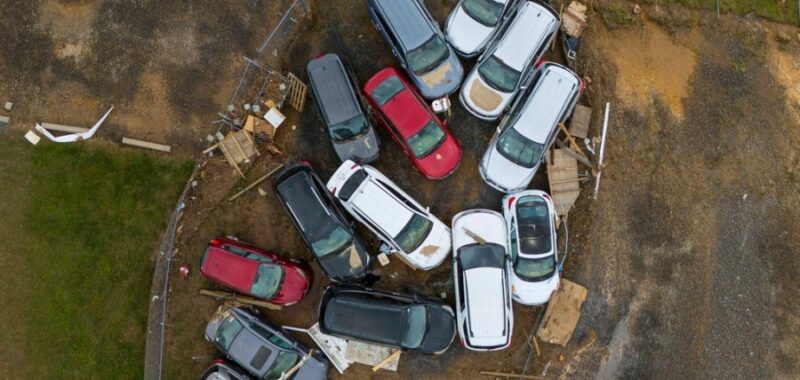
It is painful to hear someone’s voice crack as he tells the story of how he lost his entire livelihood and the work of the generations before him.
Ronny is a farmer in his 70s in a small town in Western North Carolina. His family’s fortunes drastically changed last month when Hurricane Helene flooded and destroyed his farm, washing away several lifetimes of work and the hope of passing along the family tradition to the next generation.
The tragedy of Ronny’s story is that it is similarly shared by thousands of other North Carolinians who lost their homes, businesses and entire communities in the historic flooding disaster.
Once the television cameras leave and long after the national media stop covering the extent of the devastation, many North Carolinians like Ronny and his family will still have their entire world turned upside down.
Helene tragically took the lives of more than 120 North Carolinians and more than 200 across the Southeast, a figure that is expected to grow. Helene also caused tens of billions of dollars worth of damage to an area in Western North Carolina the size of Massachusetts. Entire towns have been reduced to rubble and mud. The recovery process will be long and difficult and will require years and billions of dollars of assistance.
That is why it is so important for elected officials in Congress to step up and be proactive — not reactive — with long-term disaster recovery assistance. This is why I have led a bipartisan group of senators in disaster-hit states calling on Congress to end its seven-week recess and come back to Washington to pass a disaster funding package that initiates the long-term recovery process for victims and communities ravaged by Helene and Milton.
The most pressing need is to replenish the Small Business Administration’s disaster loan fund, which has already run out of money. Few Helene victims have flood insurance, so the SBA’s various disaster recovery programs are key to long-term recovery. By utilizing these programs, victims can access low-interest loans to replace lost property or repair or rebuild their homes or small businesses. The loans can also be used to provide a financial cushion for small businesses that face an economic loss in the months ahead due to the storm.
Now that funding for the SBA disaster loan program has run out, it risks delays in processing storm victims’ loans and their ability to get their lives back together. We cannot let this continue to go on.
FEMA is also in danger of running out of money in its Disaster Relief Fund. The hurricane season isn’t over until November and the National Hurricane Center is already monitoring tropical disturbances that could turn into more full-blown storms. It may only get worse.
Earlier this summer, FEMA had to impose Immediate Needs Funding restrictions to manage the possibility of depleting the Disaster Relief Fund during an active hurricane season. This halted the funding stream for more than 3,000 non-lifesaving projects, delaying long-term recovery efforts from previous storms and placing an even greater burden on local governments. This included nearly 200 projects totaling nearly $200 million in Louisiana alone.
While FEMA lifted the Immediate Needs Funding restriction on Oct. 1 after Congress passed a continuing resolution to replenish the Disaster Relief Fund fund, it may soon be back to square one. This risks further delaying rebuilding efforts in communities that were devastated months and years ago to respond to short-term needs. Congress owes it better to disaster victims than essentially robbing Peter to pay Paul.
The fact is, the federal disaster response and recovery process is broken and many Americans understandably have concerns.
First, there are questions about prioritization. It was telling that in a 24-hour period in the wake of Helene, the Biden-Harris administration bragged about sending $100 million in transportation funding to rebuild roads in Western North Carolina as it also pledged $157 million in assistance to Lebanon. That is reflective of an administration that can’t read a room and doesn’t have its priorities in order. Wrong message, wrong time.
Additionally, there has been a big political dust-up over FEMA money being used for illegal immigrants. This confusion could have been avoided if FEMA had been laser-focused on its mission to respond to natural disasters. FEMA should never have become a funding conduit for responding to the Biden-Harris administration’s border security crisis.
Secondly, and most important, is the question about competency. The federal government is already too slow and bureaucratic, but the disaster recovery process takes it to another level. The long-term funding for recovery is, shockingly, neither permanent nor predictable and requires constant reauthorization from Congress. I have worked across the aisle to introduce legislation that would help fix this problem by establishing a permanent and predictable funding process for long-term recovery and getting assistance to families and business owners sooner.
There also needs to be a drastic improvement in how FEMA assists victims who suffer property damage. I recently introduced a bipartisan bill to end the “one-size-fits-all” approach to disaster relief and cut the red tape that prevents many individuals and communities from accessing the relief they desperately need when they need it.
The reality is that Congress can’t correct the questionable decisions and errors made by the federal and state governments during the Helene response efforts in Western North Carolina. And make no mistake: those errors will be closely scrutinized in the weeks and months ahead.
However, what Congress can and must do is make sure the Helene recovery process goes smoother by passing a disaster assistance package as soon as possible. And it certainly won’t hinder the recovery effort if Congress also cuts some of the bureaucracy and red tape along the way.
Thom Tillis, a Republican, is the senior senator from North Carolina.

